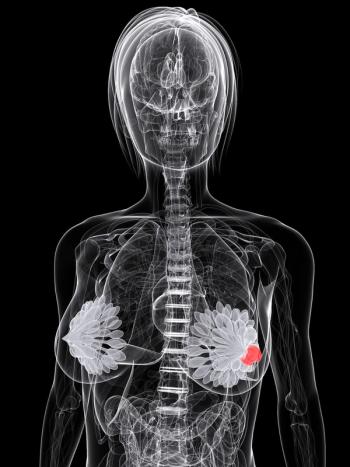
- ONCOLOGY Vol 39, Issue 1
- Volume 39
- Issue 1
- Pages: 16-17
Nodal Marginal Zone Lymphoma and Its Diagnostic Challenges
A pathologist discusses the challenges of diagnosing nodal MZL, including its lack of specific defining characteristics.
Nodal marginal zone lymphoma (MZL) presents a unique diagnostic challenge for pathologists. Unlike other lymphomas with well-defined markers, MZL lacks a specific phenotype or genetic signature. This ambiguity makes diagnosis often a process of exclusion, requiring careful consideration of clinical and radiological findings.
CancerNetwork spoke with Alexandar Tzankov, MD, surgical pathologist and head of the Department of Histopathology and Autopsy at the Institute of Medical Genetics and Pathology at University Hospital Basel, University of Basel, regarding the complexities of MZL diagnosis. He emphasized the need for a multidisciplinary approach that incorporates clinical information, radiological findings, and pathological examination. Additionally, he underscores the importance of bone marrow involvement in MZL, which is often underestimated and can significantly impact treatment decisions.
Overall, Tzankov’s insights as a pathologist help to provide guidance for oncologists in navigating the diagnostic and treatment landscape of MZL.
From a pathologist’s point of view, what is nodal MZL?
Tzankov: Nodal MZL is challenging from the perspective of pathology since [it belongs] to low-grade lymphomas that are not defined by a specific phenotype, like mantle cell lymphomas that express [cyclin-dependent kinase] 1 or follicular lymphomas that express germinal center markers. They are also not defined by a single genetic operation, especially not by a specific translocation, although they occasionally show some recurrent genetic changes. This makes the diagnosis challenging, like the diagnosis of exclusion. If one reads the definition of this disease, it’s a primary nodal B-cell neoplasm that morphologically resembles lymph node involvement by MZL but without evidence of extranodal or splenic disease. At the end of the day, establishing the diagnosis is not very easy.
On the one hand, you need some clinical and radiologic information on whether the spleen is involved and whether [the disese is] involved in external organs. This is something that you usually don’t know at the time a biopsy of a lymph node is done, and you probably provide a descriptive diagnosis of a B-cell lymphoma without a specific phenotype that has to be contextualized based on findings of other disciplines. On the other hand, it makes things also interesting, and this is for sure one of the lymphoma subtypes for which the lymphoma conferences, after the diagnosis, are quite useful to put all the information together.
How does bone marrow involvement play into nodal MZL, and does that impact prognosis and treatment decisions?
Tzankov: The bone marrow involvement is a little bit underestimated and a poorly studied issue in this consideration, and it will never be sufficiently studied, especially nowadays in the times of sophisticated staging methods, especially PET scans. Nevertheless, it’s rather more common than anticipated. It’s nonspecific, and could be interstitial, peritubular, nodular, or diffuse, and depending on the extent of the involvement, it could be easy to diagnose or be more complicated to diagnose. There are several problems in that consideration; some MZLs [do not have much aspiration], so the aspirational cytology and the flow cytometry of the bone marrow may underestimate what is going on.
On the other hand, histopathology, [when it is used], because of the lack of specific phenotype, may also be difficult to interpret. The use of molecular techniques is decisive to reaching a final diagnosis, which is [an uphill] battle since MZLs appear analogous to some follicular lymphomas and limited stage, but no MZLs can be considered potential candidates for curative irradiation, and this may not be the case in cases involving the bone marrow. The most important issue here is to properly address the bone marrow involvement whenever a patient is considered for curative local radiotherapy. The diagnostic hematopathologist should be aware that reaching a final diagnosis may be tricky and that using sequencing techniques to discern the clonal relationship between the B cells in the bone marrow and in the lymph nodes may be applicable in that particular consideration. A tricky issue with many caveats, but all I have said is not based on prospective or retrospective large case studies, but rather on my personal opinion from the 25 years of practice that I have.
What are the important prognostic factors for MZL, and how do they influence treatment decisions?
Tzankov: Beyond the clinical prognostic factors that are more or less summarized in [the Follicular Lymphoma International Prognostic Index] analogous scoring, there are not a lot of well-established prognostic factors in nodal MZL. The involvement of the bone marrow that we discussed previously is probably not a sole prognostic marker, but it can discern between patients with limited-stage disease who may be potentially curable with the irradiation. This by no means [states] that patients with bone marrow involvement would for sure have poorer outcomes. Yet, the probability of having poor outcomes is higher. A high proliferation rate, over 50%, is rather suggestive of more aggressive behavior of the MZL; the presence of complex karyotypes is considered a probable negative prognostic factor, and there are some limited studies suggesting that NOTCH3 mutations, or TP53 mutations, or mutations of a gene called TBL1XR1 may forecast more aggressive clinical behavior, but all this information is from a limited number of studies with a limited number of patients and rather retrospective ones.
In addition, maybe the detection of sheets of blasts by the hematopathologist when diagnosing MZL may be linked to more aggressive behavior. Yet the books are still not closed [on] how to define these sheets of blasts. It’s suggested that the monotonous proliferation of large cells that are more than 20% of the neoplastic population would meet this criterion. Everything is not well established and is rather based on information from retrospective or limited numbers.
Looking toward the future, where do you hope to see this field go next?
Tzankov: Dealing with nodal MZL, we’re probably not dealing with just 1 single disease, but maybe with diseases that rely on mutations in different pathways. Cases that are more linked to mutations in the NOTCH pathway compared with cases that are linked to more mutations in the WNT signaling pathway, and maybe for lymphomas relying on the activation of different mutational pathways, will go for more tailored treatment. This is on the one hand with respect to treatment. This is something that I estimate should be in the far future in terms of diagnostics. I suppose that the mutational profiles that are useful in single cases would be helpful to discern difficult cases of nodal MZL. I expect genomics to be more broadly applied in differential diagnosis and difficult-to-classify cases. Not all MZL is, unfortunately, defined by a positive phenotype or by a quite characteristic chromosomal translocation, yet they have some characteristic mutational profiles that may be useful in single cases. This would be one of the next steps.
Articles in this issue
10 months ago
Advancing the MZL Landscape Through the MZL Workshop10 months ago
Pinpointing Ways to Overcome Challenges in MZL10 months ago
Outlining Incidence Trends and Disparities of MZLNewsletter
Stay up to date on recent advances in the multidisciplinary approach to cancer.

















































































